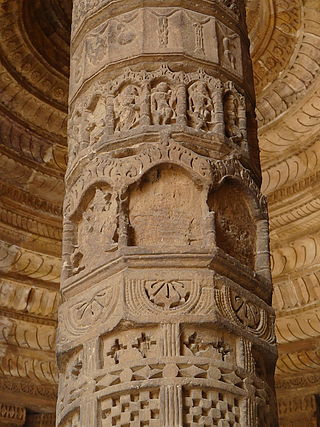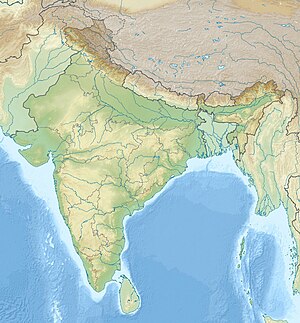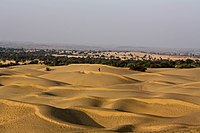
Chauhan, a name derived from the historical Chahamanas, a clan name associated with various ruling Rajput families in the present-day Indian state of Rajasthan from seventh century onwards.

Prithviraja III, popularly known as Prithviraj Chauhan or Rai Pithora, was a king from the Chauhan (Chahamana) dynasty who ruled the territory of Sapadalaksha, with his capital at Ajmer in present-day Rajasthan. Ascending the throne as a minor in 1177 CE, Prithviraj inherited a kingdom which stretched from Thanesar in the north to Jahazpur (Mewar) in the south, which he aimed to expand by military actions against neighbouring kingdoms, most notably defeating the Chandelas.

The Second Battle of Tarain was fought in 1192 between the Ghurid forces of Muhammad Ghuri and the Rajput Confederacy of Prithviraj Chauhan. It took place near Tarain, which is 110 kilometres (68 mi), north of Delhi. The battle ended in a decisive victory for the invading Ghurids and their successful penetration in north Indian plain.

The history of human settlement in the western Indian state of Rajasthan dates back to about 100,000 years ago. Around 5000 to 2000 BCE many regions of Rajasthan belonged as the site of the Indus Valley Civilization. Kalibangan is the main Indus site of Rajasthan, here fire altars have been discovered, similar to those found at Lothal.
The First Battle of Tarain, also spelt as the First Battle of Taraori, was fought in 1191 between the invading Ghurid army led by Muhammad of Ghor and the Rajput Confederacy led by Prithviraj Chauhan, near Tarain. The battle ended in decisive victory for the Rajputs; however, Muhammad of Ghor managed to escape and returned to Ghazni.

Bahram-Shah was Sultan of the Ghaznavid Empire from 25 February 1117 to 1152. Son of Mas'ud III and Gawhar Khatun, sister of Sanjar, sultan of the Great Seljuq Empire. During his entire reign, his empire was a tributary of the Great Seljuq Empire.

Harakeli Nataka is a Sanskrit drama written by the Chahamana (Chauhan) king Vigraharaja IV alias Visaladeva, who ruled from 1150 to 1164 CE. This drama is based on Kiratarjuniya of writer Bharavi.The play is also called Lalita Vigraharaja Nataka.

The Chahamanas of Shakambhari, colloquially known as the Chauhans of Sambhar or Chauhans of Ajmer, were an Indian dynasty that ruled parts of the present-day Rajasthan and neighbouring areas in India, between the 6th and 12th centuries. The territory ruled by them was known as Sapadalaksha. They were the most prominent ruling family of the Chahamana (Chauhan) Rajput clan.
The Chahamanas of Naddula, also known as the Chauhans of Nadol, were an Indian dynasty. They ruled the Marwar area around their capital Naddula between 10th and 12th centuries. They belonged to the Chahamana (Chauhan) clan of the Rajputs.

Vigraharāja IV, also known as and also Visaladev was a king from the Chahamana (Chauhan) dynasty in north-western India, and is generally considered as one of the greatest rulers of the dynasty. He turned the Chahamana kingdom into an empire by subduing the neighbouring kingdoms of Chaulukya, Naddula, and Tomara kingdoms. He also repulsed Muslim invasions, from the Ghaznavid ruler Bahram Shah and defeated Khusrau Shah in Vigraharaja IV's first war against the Muslims.
Chamundaraja was an Indian king belonging to the Shakambhari Chahamana dynasty. He ruled the Sapadalaksha country, which included parts of present-day Rajasthan in north-western India.
Durlabharaja III was an Indian king belonging to the Shakambhari Chahamana dynasty. He ruled the Sapadalaksha country, which included parts of present-day Rajasthan in north-western India.
Ajayaraja II was an Indian king belonging to the Shakambhari Chahamana dynasty. He ruled the Sapadalaksha country, which included parts of present-day Rajasthan in north-western India. He defeated the Paramaras of Malwa, and also repulsed the Ghaznavid invasions after losing some part of his territory to them. The establishment of the Ajmer city is attributed to him.
Arnoraja was an Indian king belonging to the Shakambhari Chahamana dynasty. He ruled the Sapadalaksha country, which included parts of present-day Rajasthan in north-western India. Arnoraja defeated the Ghaznavid king Bahram Shah in the Slaughter of Turushkas near Ajmer, and also defeated several neighbouring Hindu kings including the Paramaras and the Tomaras. He had to face defeats against the Chaulukyas, and was ultimately killed by his own son, Jagaddeva.
Hariraja was a king from the Chauhan (Chahamana) dynasty who ruled parts of his ancestral kingdom for a brief period, before being defeated by the Ghurids. After the Ghurid invaders defeated his brother Prithviraja III in 1192 CE, he dethroned his nephew Govindaraja IV, who had been appointed as a vassal ruler by the Ghurids.
Anahilla was an Indian king belonging to the Naddula Chahamana dynasty. He ruled the area around Naddula. He defeated the Chaulukya king Bhima I, defeated a general of the Paramara king Bhoja, and also defended his territory against the Ghaznavids.
Alhana-deva was an Indian king belonging to the Naddula Chahamana dynasty. He ruled the area around Naddula, as a vassal of the Chaulukya king Kumarapala. During his reign, the Chahamanas of Shakambhari invaded Naddula, and Kumarapala replaced him with his own governors. Later, Kumarapala restored his rule in Naddula, as a result of his service in Chaulukya military campaigns.

The Battle of Kasahrada, also known as Battle of Kayadara or Battle of Gadararaghatta was fought in 1178 at modern Kasahrada in Sirohi district near Mount Abu in present-day Rajasthan. It was fought between the Rajput Confederacy led by Mularaja II and the invading Ghurid forces led by Muhammad of Ghor, during which the Ghurid forces were signally defeated.

The Ghurid campaigns in India were a series of invasions for 31 years (1175–1206) by the Ghurid ruler Muhammad of Ghor in the last quarter of the twelfth and early decade of the thirteenth century which lead to the widespread expansion of the Ghurid empire in the Indian subcontinent.
Vigraharaja IV's first war against the Muslims took place in the later half of the 12th century CE between the forces of the Ghazanvid Empire under Khusrau Shah of Ghazna and the Chauhan dynasty under Vigraharāja the great. In this momentous confrontation, the Chahamana ruler, successfully defended the region against the relentless onslaught of Muslim invaders from the northwest.











